
HPU2. Nat. Sci. Tech. Vol 03, issue 02 (2024), 50-58.
HPU2 Journal of Sciences:
Natural Sciences and Technology
Journal homepage: https://sj.hpu2.edu.vn
Article type: Research article
Received date: 08-4-2024 ; Revised date: 07-6-2024 ; Accepted date: 12-7-2024
This is licensed under the CC BY-NC 4.0
50
Study on the adsorption L- and D- proline on MKN-MWCNT-P5000
carbon nanotubes from aqueous solutions
Dinh-Tuan Le
*
, Anh-Van Chu
Hanoi Pedagogical University 2, Vinh Phuc, Vietnam
Abstract
Carbon nanotubes (CNTs) are a new type of nano-adsorbent material with unique properties, which
are promising adsorbents for the separation of enantiomers. Information regarding the interaction
mechanism of enantiomers with carbon nanotubes has not yet been fully explored yet. In this work, we
studied the adsorption of L and D-proline on carbon nanotubes in aqueous solution. Adsorption
isotherms of enantiomers proline on multi-walled carbon nanotube MKN-MWCNT-P5000 from
aqueous solution at 25
℃
were constructed. The results of the experiments show that the adsorption
capacity of the D-isomer is higher than that of the L-isomer. The separation coefficient of enantiomers
on carbon nanotubes is in the range of 1.88–7.92. L-proline was adsorbed on CNTs as zwitterions and
clusters of 62 molecules; and D-proline - in the form of zwitterions and clusters of 33 molecules. The
results of quantum chemistry show that the adsorption energy of the D-proline monomer on carbon
nanotubes is greater than that of the L-isomer. The nature of the bond between enantiomers and
nanotubes was Van der Waals force.
Keywords: Carbon nanotubes, enantiomers of proline, adsorption, computer simulation
1. Introduction
A carbon nanotube (CNT) is visualized as a rolled graphene sheet. This is a new nano-adsorbent
material with unique adsorption, mechanical, optical, and electrical properties [1]. Because of these
properties, carbon nanotubes have become important materials in biomedical technology, such as
developing new generation biosensors, targeted drug delivery platforms, and tissue engineering [2]–
[4]. The chiral nature of carbon nanotubes and their high adsorption properties make it possible to
consider nanotubes as promising adsorbents for the separation of enantiomers. However, in practice,
there is very little research, which has been published on this issue. One of them is our work [5]–[7].
*
Corresponding author, E-mail: ledinhtuan@hpu2.edu.vn
https://doi.org/10.56764/hpu2.jos.2024.3.2.50-58

HPU2. Nat. Sci. Tech. 2024, 3(2), 50-58
https://sj.hpu2.edu.vn 51
Realizing the properties of nanotubes in biotechnology requires understanding the nature of the
interactions between biomolecules and CNTs [8]–[15]. Therefore, studying the interaction of amino
acids with CNTs is necessary because amino acids are the simplest structural units of many biological
molecules. Proline is one of the basic amino acids that make up proteins. No studies on the interaction
mechanism of this amino acid with multi-walled carbon nanotube MKN-MWCNT-PT5000 have been
published. Therefore, proline and carbon nanotube MKN-MWCNT-PT5000 were chosen as research
objects.
This work aims to study the adsorption interaction of L- and D- proline with MKN-MWCNT-
P5000 carbon nanotubes in an aqueous solution at 25℃.
2. Experimental
2.1. Construction of adsorption isotherm
In this experiment, multi-walled carbon nanotube MKN-MWCNT-P5000 brand Sigma-Aldrich,
originating from Canada with 95% purity, tube length over 50 μm, and outer diameter from 10–30 nm
was used as the adsorbent. These are a mixture of nanotubes with different chirality. L- and D-proline
are chemicals from Sigma-Aldrich with purity over 99% (pK-COOH = 1.99; pK-NH-= 10.60; pI=
6.30). To determine the adsorption capacity of amino acids on carbon nanotubes, 0.01 g of MKN-
MWCNT-P5000 CNT was added to amino acid solutions with different concentrations. Then, the
resulting solution was subjected to ultrasonic treatment for 3 minutes using a MEF91 ultrasonic unit.
The resulting suspension was shaken well in an ES-20 incubator-shaker until equilibrium was
established at 25℃ according to the kinetic investigation time (15 h). The resulting solutions were
then filtered through a pleated filter and centrifuged. The proline concentration in the supernatant was
determined by measuring the optical density of the solution using a Shimadzu UV-1800
spectrophotometer at 520 nm. The adsorption isotherm was built using the volume method combined
with the concentration change method. Under experimental conditions, the pH value of the solution
ranges from 5.43 to 5.60. Proline in aqueous solution exists at these pH values in the zwitterion form
(Figure 1.).
Figure 1. Distribution diagram of proline's ion forms according to pH [16].
2.2. Quantum modelling
Quantum modeling of the L- and D-proline–CNT system was performed using the Gaussian 09
program with the B3LYP/6-31G(d,p) GD3 method, which allows calculating the energy of these
structures, takes into account dispersion correction [17]. The influence of the solvent is taken into

HPU2. Nat. Sci. Tech. 2024, 3(2), 50-58
https://sj.hpu2.edu.vn 52
account using the Tomasi PCM continuous polarization method. The interaction energies between
amino acids and CNTs are calculated according to the formula:
–
ad CNT AA AA CNT
E E E E
(1)
Here, Ead is the adsorption energy; ЕCNT is the energy of CNT; EAA is the energy of the amino acid;
EAA+CNT is the energy of the system “amino acid – CNT”.
A dextrorotatory nanotube with chiral indices (7, 5) with a length of ~13 Å was used as a model
nanotube in a computer experiment. Since in the experiment, nanotubes with a length-to-diameter ratio
of approximately 2500 were used in the experiment, most of the AA will be adsorbed on the lateral
surface of the CNT. Therefore the contribution to the isotherm due to adsorption at the CNT tips being
negligible compared to the contribution of adsorption at the side surface. The nanotubes used have a
small defect concentration, so AA is unlikely to penetrate inside the CNT. Therefore, when
performing quantum modeling, the adsorption process is performed on the outer surface of the
nanotube. The use of open-ended tubes in calculations is due to the complexity of the procedure for
closing the ends of nanotubes and the influence of the end of the tube on the adsorption of the side
surface is negligible. Calculations were performed at the VSU Supercomputing Center and the
Siberian Supercomputing Center.
2.3. Cluster adsorption model
The isotherms are interpreted based on the cluster adsorption model. This model was developed
in [18], for the case where adsorbate molecules A exist in solution as monomers, thereby forming
clusters of different sizes on the surface of the adsorbent S according to the equilibriums:
2
n
S+ A SA
S+ 2A SA
...
S+ nA SA
(2)
The adsorption equation in this case has the form [18]:
n
2
2 n
2 n
e e n e
m m
1 2
m2 n
e e n e
1 2
K C + K C +...+ K C
q = q 1+ K C + K C +...+ K C
(3)
Here q - adsorption capacity, Ce - equilibrium concentration, Ki - equilibrium coefficient of the
adsorption reaction S + iA = SAi, i = 1, 2, ..., n - number of adsorbate molecules; mi - the number of
adsorbate molecules (ions) in the first layer since the cluster contains i molecules (ions), qm - the
monolayer adsorption capacity, n - the maximum size of the adsorbate cluster.
3. Results and discussion
The adsorption isotherms of L- and D-proline on MKN-MWCNT-P5000 CNTs are shown in
Figure 2. Figure 2. shows that, for L-proline, when the equilibrium concentration of the external
solution is small (Ce < 0.017 M) if increasing the AA concentration, the adsorption increases steadily.
In the region of 0.017 M ≤Ce ≤0.019 M, if the equilibrium concentration of L-proline increases, the
isotherm is almost vertical, showing a sudden increase in adsorption. When continuing to increase the
concentration of L-proline, the isotherm has a very small slope, almost parallel to the horizontal axis,
proving that the adsorption level is almost unchanged. For the D-proline, when Ce < 0.007 M, the
value of q gradually increases with increasing concentration of D-proline. In the region 0.007 M ≤ Ce

HPU2. Nat. Sci. Tech. 2024, 3(2), 50-58
https://sj.hpu2.edu.vn 53
≤ 0.008 M, the isotherm is almost a vertical line parallel to the vertical axis. This shows a sudden
increase in the adsorption value at this concentration range. When Ce > 0.008 M, as Ce increases, the
value of q increases very little, and the slope of the graph gradually decreases.
Figure 2. Adsorption isotherm of L- and D-proline from aqueous solution on CNT MKN-MWCNT-P5000.
Experimental results show that CNT MKN-MWCNT-P5000 adsorbs the D-proline better than the
L-proline at 25℃, proving that the affinity of CNT for D-proline is higher than its enantiomer. This
will be explained based on quantum modeling results in the following section. The higher adsorption
capacity of D-proline on CNT is due to the different interactions of enantiomers with chiral carbon
nanotubes. To evaluate the ability to separate L- and D-proline on nanotubes, the distribution
coefficient of proline isomers between CNTs and solutions - KL and KD, as well as the separation
coefficient of enantiomers “α” on these CNTs calculated according to the formula:
D
L
K
K
α = (4)
where KD is the distribution coefficient of D-proline on carbon nanotubes in aqueous solution, and KL
is the distribution coefficient of L-proline on carbon nanotubes in aqueous solution. The distribution
coefficients KD and KL are equal to the ratio between the equilibrium concentrations of D- and L-
proline in the adsorbent and the solution:
D(L)
e
C
K = C
ads
(5)
The results obtained are shown in Figure 3. Figure 3. shows that the separation coefficient
gradually increases when the initial concentration of AA increases to 0.02 M (respectively α = 7.92).
Then, this value gradually decreases with increasing initial concentration. The α value obtained is
higher than the data presented in the literature for other adsorbents [19]–[21] (α =1.82-3.74). The data
in Figure 3. allow us to conclude that the MKN-MWCNT-P5000 nanotube is a promising adsorbent
for proline separation. The parameters of the cluster adsorption isotherm equation (3) are determined
from the condition of the smallest deviation of the experimental isotherms compared to the model (3).
Calculations show that the best agreement between experiment and theory occurs if the adsorption
isotherm equations take the form:
n
n
nnm1
mn
n
1
K C + K C
q = q 1+ K C + K C
e e
e e
(6)

HPU2. Nat. Sci. Tech. 2024, 3(2), 50-58
https://sj.hpu2.edu.vn 54
This equation describes the adsorption of monomers and clusters made up of the maximum
possible number of molecules (ions). The formation clusters with the largest possible size are
energetically favorable since larger clusters include a larger number of AA-AA bonds, contributing to
lowering the energy of the system during the adsorption process. Numerical values of model
parameters (6) for D- and L-proline on CNT are presented in Table 1.
Figure 3. Chart of separation coefficient α at different initial concentrations of amino acids.
Table 1. Parameters of adsorption isotherm equation (6) of L- and D-proline on CNT.
Isomer qm
(mol/g)
K1
(mol/l)-1
Kn* n
mn
R2
L 5.43 10-2
8.94 1.9710107 62
62 0.999
D 7.1310-2 10.00 1.311070 33
33
0.996
*The dimension of the coefficient Kn corresponds to the condition that the quantity
n
n e
K C
is dimensionless.
Isothermal equation (6) includes parameters that characterize the structure of AAs on CNTs.
Specifically, the number of adsorbed zwitterions bound together into clusters is equal to the exponent
of concentration (n) in the isotherm equation (6) and the number of zwitterions in the first adsorbate
layer of the n-cluster equals mn. This is the physical meaning of the parameters of the cluster
adsorption equation [5]–[7], [22]. This helps determine the structure of clusters from experimental
isotherms by determining the parameters n and mn using the least squares method. The values of
structural parameters of n and mn adsorption clusters on the CNT surface are presented in Table 1.
From the value of n (Table 1), it follows that L-proline is adsorbed on CNT in the form of individual
zwitterions and clusters consisting of 62 molecules, and D-proline - in the form of individual
zwitterions and clusters of 33 molecules. Thus, all monomers of L- and D-proline clusters are located
on the surface of CNT (monolayer adsorption). This conclusion is made because the number of
molecules in the first layer mn equals the number of molecules in cluster n (mn= n), Table 1. The
physicochemical reasons for cluster formation are explained in the work of us [5]–[7], [22]. Note that
monolayer cluster adsorption is the most favorable adsorption process if the adsorbent surface area is
sufficient to cover one layer because in this case the interaction between not only the adsorbate and
adsorbent but also adsorbate-adsorbate, contributing to reducing the energy of the system during the
adsorption process [22]. The monolayer cluster adsorption isotherm equation is a generalization of
Langmuir's theory in the case of taking into account the adsorbate-adsorbate interaction between the
molecules of the first layer [22]:

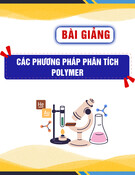
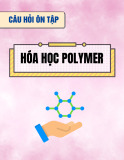

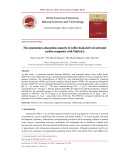
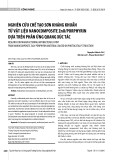
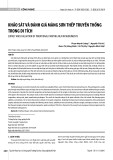
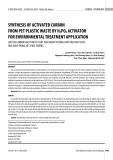
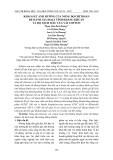

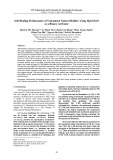




![Ô nhiễm không khí từ nông nghiệp: Thách thức toàn cầu và định hướng hành động [Mới nhất]](https://cdn.tailieu.vn/images/document/thumbnail/2025/20250917/kimphuong1001/135x160/52891758099584.jpg)










